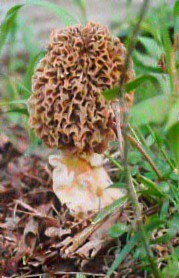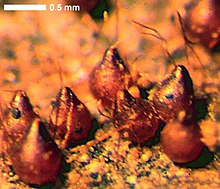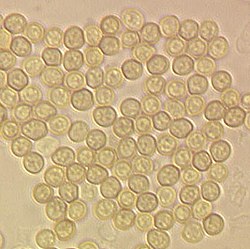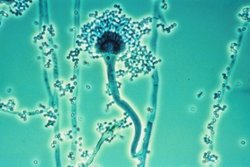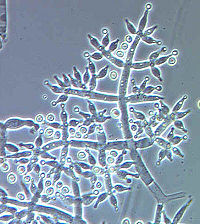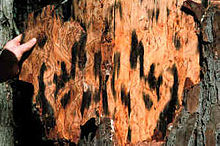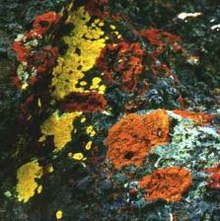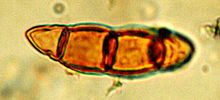Ashes
| Ashes | ||||||||||||
|---|---|---|---|---|---|---|---|---|---|---|---|---|
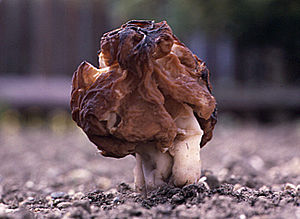
Ascocarp of the spring venomous lobster |
||||||||||||
| Systematics | ||||||||||||
|
||||||||||||
| Scientific name | ||||||||||||
| Ascomycota | ||||||||||||
| Caval.-Sm. |
The hose mushrooms (Ascomycota) form one of the largest departments in the kingdom of mushrooms (fungi). They are named after their characteristic reproductive structures, the tubular asci . Many yeast and molds , but also popular edible mushrooms such as morels and truffles belong to this group. In tribal history, they are very likely the sister group of the mushroom mushrooms (Basidiomycota) and together with them form the taxon Dikarya . A majority of the fungi that used to be in a separate group without sexual stages in their life cycle (Deuteromycota) can now be classified as cucilus fungi based on molecular genetic data.
Ashlar mushrooms are of great importance to humans, as on the one hand they are responsible for numerous diseases of plants, pets and humans, on the other hand they also play an important role in the production of foods such as cheese and bread , beer and wine and also in medicine , where the antibiotic penicillin produced by Penicillium chrysogenum has revolutionized the fight against bacterial infectious diseases , are of importance that should not be underestimated. As fungal partners in lichens and as so-called mycorrhizal fungi, as well as fungi play an important role in many ecosystems .
construction
Many sac fungi are made up of long but only about five micrometer thin cell threads, the hyphae , which often branch out repeatedly and thus form a woolly tangled network, the mycelium , which is usually a few centimeters in size. The hyphae contained therein, however (hypothetically placed next to each other) would usually reach a length of one or even several kilometers. The other extreme is the unicellular yeast , which can often only be seen with a microscope. A number of species, such as classic baker's yeast ( Saccharomyces cerevisiae ), are dimorphic , which means that they can occur in both single and multicellular forms.
The cell wall in pouches almost always consists of chitin and β- glucans ; individual cells are characteristically separated by transverse walls, the septa. These give the hypha stability and prevent extensive loss of cytoplasm if the cell membrane should break open locally. As a result, as opposed to the moisture-loving yoke mushrooms (Zygomycota), cucumbers can also survive in dry habitats. Most of the transverse walls, however, are centrally perforated, i.e. they have a small opening in the middle through which the cell plasma and also cell nuclei can move more or less freely throughout the hypha. Most hyphae contain only one nucleus per cell, which is why they are called uninucleates .
The ascocarp
In many, but by no means all, hose fungi, in the course of sexual reproduction, a macroscopic fruiting body, which is visible to the naked eye and made of very closely interwoven cell threads, is called ascocarp or ascoma and is consumed as an " edible mushroom " in truffles, for example becomes. It consists of sterile and fertile hyphae. The latter form the multiplication cells called spores and are often grouped together in their own fruit layer, the hymenium . They mostly develop on the inner surface of the ascocarp.
With no relevance to the systematics of mushrooms, ascocarps are classified according to their location, among other things: if the fruiting body is above the ground, as is the case with morels ( Morchella ), it is called epigee , if it is underground, as with truffles ( tuber ), it is called hypogean . A distinction is also made between types of shapes
- the apothecium : here the ascocarp is open upwards like a cup. The fruit layer (hymenium) is exposed so that numerous spores can be spread at the same time. Apothecia have for example the morels and lorels.
- the celistothecium : In this case the ascocarp is spherical and closed, so the spores cannot be released independently. As a result, fungi with cloistothecia had to develop new strategies for spreading their spores. The truffles have solved this problem, for example, by attracting animals such as wild boars , which can break open the tasty ascocarps and transport the spores attached to them over longer distances. Kleistothecia are usually found in mushrooms that have very little space available for their ascocarp, for example those that live below the bark of trees or, like truffles, in the ground. The skin fungi of the Arthroderma genus also form celistothecia.
- the perithecium : Perithecia have the shape of a cone or a sphere. Their peculiarity is that on the upper side there is a small pore, the ostiole , through which the spores are released one after the other at maturity - in contrast to apothecia. Perithecia can be found, for example, in the wooden clubs ( Xylaria ) but also in the pustular mushrooms ( Nectria ).
- the pseudothecium : As with the perithecia, the spores are formed in pseudothecia in an outwardly open cavity. Here, the fruiting bodies are formed ascolocularly , in that the haploid mycelium is formed before the fertilization and the dikaryotic hyphae grow into a cavity that is created later, the loculus with the asci. The difference lies in the type of spore release described in more detail below: In pseudothecia, so-called bitunicate spore tubes occur, which expand when water is absorbed and thus literally push the spores inside them out of the opening. Examples of species are apple scab ( Venturia inaequalis ) or horse chestnut leaf tan ( Guignardia aesculi ).
metabolism
As with most mushrooms, as well as mushrooms primarily decompose living or dead biomass. To do this, they release powerful digestive enzymes into their surroundings , which break down organic substances into small fragments, which are then absorbed through the cell wall. Many species live on dead plant material such as fallen leaves, twigs or even whole tree trunks. Others attack plants, animals or other fungi as parasites and gain their metabolic energy and all the necessary nutrients from the cell tissue of their host. Particularly in this group there are sometimes extreme specializations; so many species only attack a certain leg of a specific insect species . In addition, as well as fungi are often found in symbiotic relationships. For example, with various algae cells or cyanobacteria , from which they receive high- energy photosynthesis products, they form lichens - others cooperate with forest trees as mycorrhizal fungi . Finally there are even carnivorous fungi that have developed with their hyphae cases in which small protists such as amoeba , but also animals such as nematodes (Nematoda), rotifers (Rotifera), water bears (tardigrades) or even small arthropods such as springtails (Collembola ) can get caught.
In the course of their long tribal history, sac fungi have acquired the ability to break down almost any organic substance. In contrast to almost all other organisms, they are able to break down vegetable cellulose or the lignin contained in wood using suitable enzymes. Also collagen , an important animal structural protein or keratin , are made of the hair, for example, serve as mushrooms "food source". More exotic examples are provided by Aureobasidium pullulans , which metabolizes wall paint, or the kerosene fungus ( Amorphotheca resinae ), which feeds on kerosene (petroleum) and as a result often clogs the fuel lines of aircraft.
distribution and habitat
Ascent fungi are found in all land-based ecosystems around the world, as lichens they even occur in the Antarctic . The distribution of individual species, on the other hand, is very variable: some are found on all continents, others such as the culinary highly coveted white truffle ( Tuber magnatum ) only regionally in isolated areas of Italy and France.
As already mentioned, the transverse walls or septa between the cells allow the mushrooms to colonize much drier habitats than, for example, the yoke mushrooms . This dehydration resistance is extremely pronounced in individual species that grow on salted fish because of the enormous osmotic pressure that occurs there . On the other hand, a group (albeit in the minority) has returned to the water.
Reproduction
The reproduction of asexus mushrooms is very diverse, it can happen in both asexual and sexual ways. The latter is particularly characteristic because of the reproductive structures that are formed, the tubular asci . On the other hand, asexual reproduction plays by far the greater role; many species have given up sexual reproduction entirely.
Basically, a distinction is made between two fundamentally different states in the life cycle of pouches, the anamorphic , the asexual stage, and the teleomorphic , the sexual stage, which is not always present. The totality of anamorph and teleomorph is sometimes referred to as a holomorph .
Since teleomorph and anamorph are often not externally similar in any way, it was often not possible to assign the stages to one another until the late 20th century. This led to the curious, but taxonomically accepted situation to this day, that two different life stages of one and the same mushroom are assigned to different "species" and thus have different names. For example, the sexual manifestation of the kerosene fungus is known under the name Amorphotheca resinae , while Hormoconis resinae denotes the asexual stage. However, today more and more connections between these “species” are uncovered through molecular genetic methods, so that the earlier division of the asexual stages into a separate division, the Fungi imperfecti (Deuteromycota), has now become obsolete.
Asexual reproduction
Asexual reproduction is the dominant form of propagation in hose fungi and is responsible for the rapid spread of the fungi in an area that has not yet been developed. It takes place by genetically identical to the parent fungus, mostly mononuclear distribution structures Konidiosporen shortly conidia or after the manner of their production through the cellular process of mitosis also mitospores be mentioned. They are usually formed by special cells known as conidiogenic , which are located at the tip of specialized hyphae, the conidiophores . Depending on the species, they can be spread by the wind, water, but also by animals.
Koelomycetes and Hyphomycetes
The variety of types of the asexual stages, the anamorphic, is enormous. Depending on whether the spores are formed in a closed structure, a conidioma, or not, they can be roughly divided into two groups, the koelomycetes and the hyphomycetes (irrelevant for the systematics).
- Koelomycetes form their spores in outwardly closed conidiomata, which often form just below the surface of a host organism. One distinguishes
- acervular conidiomata or acervuli : They develop in the host organism and can lie below the outer layer of the plant called the cuticle (subcuticular), within the outermost cell layer, the epidermis (intraepidermal), directly below it (subepidermal) or even below numerous host cell layers . Usually a flat layer with relatively short conidiophores develops there, which then produce masses of spores. The increasing pressure as a result finally leads to the break-up of the epidermis and cuticula and thus enables the conidia to escape.
- pycnidial conidiomata or pycnidia : In contrast to the acervuli, pycnidial conidiomata form in the fungal tissue itself. They usually have the shape of a bulbous vase; the spores are released into their surroundings through the small opening at the top, the ostiole.
- In the hyphomycetes, the conidiophores, i.e. the hyphae that have conidial cells at the tip, are always exposed. They usually occur in isolation, but sometimes also in the form of parallel bundles or pillow-shaped masses; bundle-shaped conidiomata are referred to as synnematal , pillow-shaped as sporodochial .
Spurs
The spores are important for the further classification of the asexual life conditions of the asexus mushrooms, which are differentiated according to color, shape and septation:
The single cells called amerospores are probably the most common spore type . If, on the other hand, the spore is divided into two by a transverse wall (septum), one speaks of didymospores . With two or more partitions, the shape is also important. Are the septa within the spore transversely , so like the rungs of a ladder placed, they are called Phragmosporen , make it more of a contrast, net-like structure, it is called Dictyosporen . Some spores radiate out from a central body, called "staurospores"; in others the whole spore is coiled up like a feather and is then called a helicospore . Finally, very long, worm-shaped spores with a length to diameter ratio of more than 15: 1 are called scolecospores .
Conidiogenesis and dehiscence
Two other important properties of the asphyxia anamorphs are the way the spores are formed, conidiogenesis , and the way they separate, called dehiscence . The former corresponds to the embryology in animals and plants and can be divided into two fundamental forms of development, blastic conidiogenesis, in which the spore can already be perceived before it is separated from the conidiogenic hypha that forms it by a transverse wall, and thallic conidiogenesis, in which The transverse wall is formed first and the cell thus separated is then transformed into a spore.
These two basic types can be subdivided even more finely:
- In blastic-acropetal spore formation, the conidia arise through continued budding at the tip of the conidiogenic hypha, so that a long chain of spores is formed, the youngest of which is always at its tip ( apical ). If two buds form on a spore, which is then called Ramoconidium , the chain branches. Blastic-acropetal conidiogenesis is thus a variant of normal hyphal growth.
- The blastic-synchronous conidiogenesis is characterized by the fact that many spores on a centrally located, usually swollen cell form simultaneously. Sometimes these spores form secondary acropetal chains again.
- The blastic-sympodial development is characterized by the fact that after spore formation at the tip of the conidiophores, a new tip forms behind the spore, which then grows laterally ( sympodial or zymotic ). This in turn eventually forms a spore, below which a new tip emerges, etc. Inevitably, the conidiogenic cells become longer and longer during this process.
- The blastic-annellidic form of conidiogenesis is particularly striking : After a spore has formed and separated, a ring-shaped scar remains at the tip of the conidiogenic cell. This grows through this ring and then forms the next spore, which in turn leaves a scar when it is separated so that the number of rings in a conidiogenic cell can be read off the number of spores it has formed.
- In the blastic-phialidischen formation of spores at the open end which in this case arise phialids conidiogenous cells called spores always new. Since the phialids themselves do not change their shape or length, the chain of spores grows upwards in a manner similar to that in blastic-acropetal development; In contrast to this, however, the lowest spore formed on the so-called conidiogenic locus is always the youngest. The anamorph of the mold Penicillium is a well-known example of this form of conidiogenesis.
- As a variant of the blastic-phialidic form of development, the Basauxic formation can be considered. The spores of the resulting chain are in different stages of development: While the oldest spores at the top are mature, the youngest spores at the bottom have barely differentiated from the hypha below.
- The blastic-retrogressive spore formation proceeds quite differently . A spore forms at the tip of the conidiogenic hypha and is separated from it by a transverse wall. Thereupon another spore develops directly underneath, which in turn is separated from the rest of the hypha by a septum. By repeating this process several times, more and more spores are formed from a hypha from the tip downwards, while the hyphae cell itself continues to shorten.
- In contrast to the blastic forms, in thallic-arthral conidiogenesis, the septa are first formed before spore formation. In addition, a hypha first stops growing and then forms double transverse walls at irregular intervals. The individual cells thus created separate from each other in a manner called schizolytic and begin to differentiate, so that a chain of short cylindrical spores, the so-called arthroconidia , is created, which appear to be articulately connected. In a variant of this form of development, only alternating cells develop into spores; the cells in between degenerate and die, releasing the arthroconidia between them.
- Finally, the thallic-solitary form of development still exists . Here, at the end of a conidiogenic hypha, a large bulbous cell separates, in which numerous transversely arranged internal transverse walls are formed. The cell now differentiates into a phragmospore, which is separated off as a whole (in a manner called rhexolytic ).
Dehiscence can essentially take place in two different ways. In the schizolytic variant, a double partition with a centrally located middle lamella forms between the spores, which then dissolves to separate the spores. In rhexolytic dehiscence, on the other hand, the cell wall that connects the spores on the outside simply degenerates and releases the conidia in this way.
Heterokaryosis and parasexuality
In a number of pouch fungi, either no sexual stages exist or such stages are not known. Two ways of preserving genetic diversity are heterokaryosis and parasexuality . The former is caused simply by the merging of two hyphae from different organisms, a process called anastomosis . As a result, there are more cell nuclei in the mycelium than usual, which also come from genetically different "parent organisms". Parasexuality, on the other hand, describes a phenomenon in which two cell nuclei merge without any actual sexual processes, thereby doubling the number of chromosomes . This is followed by a complex form of nucleus division called mitosis , in which there is a “ crossing over ”, an exchange of genetic material between two corresponding chromosomes. (In the case of sexual forms of reproduction, on the other hand, “crossing over” only occurs in the meiosis known as the meiosis .) Finally, haploidization creates two cell nuclei, each with a set of chromosomes, which are now genetically different from the two original nuclei.
Sexual reproduction
The sexual reproduction of the ashes is characterized by a characteristic structure, the ascus , which distinguishes them from all other fungi. An ascus is a tubular meiosporangium , which means that the sexual spores are formed in it through the meiosis called meiosis , which are then called ascospores to differentiate them from the asexually formed conidiospores.
With exceptions such as baker's yeast ( Saccharomyces cerevisiae ), almost all of the ashes are haploid in their normal state , so their nuclei each have only one set of chromosomes , which makes them particularly susceptible to mutations . During sexual reproduction, there is usually a very short diploid phase (with two sets of chromosomes), which is usually followed by meiosis, so that the haploid state is restored.
Process of sexual spore formation
The sexual part of the life cycle is initiated as soon as two matching hyphae meet. These come from the same hyphae that also forms the asexual spores. The decisive factor for whether conjugation, i.e. sexual fusion, takes place is initially whether the hyphae belong to the same organism or whether they come from a different fungus. While numerous mushrooms are quite capable of self-fertilization, a trait known as homothallic , others require a genetically non-identical partner and are therefore heterothallic . In addition, the two hyphae affected must also belong to suitable mating types. These are a peculiarity of mushrooms and roughly correspond to the sexes in plants and animals; however, there can be more than two mating types.
If tolerated, the gametangia develop on the hyphae , the formation cells for the gametes in which numerous cell nuclei collect. A very fine hypha, the trichogyne , which grows out of one of the gametangia, now called the ascogonium , forms a connection through which the cell nuclei from the other gametangium, now called the antheridium , can pass into the ascogonium. In contrast to animals or plants, after the union of the cell plasmas of the two gametangia involved (plasmogamy), there is usually no immediate fusion of the nuclei (karyogamy). Instead, the immigrated nuclei from the antheridium arrange themselves in pairs with nuclei of the ascogonium, but remain independently next to them. The dikaryophase in the life cycle of the fungus has started, during which the pairs of nuclei repeatedly divide synchronously, so that their number multiplies. In all likelihood, the dikaryophase is an evolutionary adaptation and serves to fully exploit the potential of sexual reproduction in the event of a rare encounter between two individuals. Due to the repeated synchronous division of the nucleus pairs, the genetic starting material is multiplied and is combined with one another in the most varied of ways during the recombination during meiosis , so that the largest possible number of genetically different spores can arise. A similar solution to a similar problem has also developed independently of this with the red algae (Rhodophyta).
Millions of new, dinucleate hyphae are now growing out of the fertilized ascogonium , into which two cell nuclei migrate per cell . They are also called ascogenic or fertile . They are nourished by common, uni- or mononucleate hyphae with only one nucleus, which are referred to as sterile . In many cases, the network of sterile and fertile hyphae forms into the macroscopically visible fruiting body of the fungus, the ascocarp, which can contain several million fertile hyphae.
The asci now arise in the actual fruit layer, the hymenium. For this purpose, an ascogenic hypha forms a U-shaped hook at the tip, which points against the direction of growth of the hypha. The two nuclei contained in this terminal cell, i.e. at the tip of the hypha, now divide in such a way that the spindle fibers of their mitotic spindles run parallel and thus two (genetically different) daughter nuclei come to lie at the tip of the hook, a daughter nucleus the tip of the hypha, which is now aligned against the direction of growth, and another is positioned at the base of the hyphae cell. Now two parallel transverse walls are drawn in, which divide the hook into three parts: the original tip of the hypha, now pointing against the direction of growth, with a nucleus, the base of the hypha next to it, also with a nucleus, and a central area at the tip with two Cell nuclei. In the latter, if correctly positioned in the fruit layer, the actual nuclear fusion takes place, through which the diploid zygote is formed. It is now elongated into an elongated tubular or cylindrical capsule, the actual ascus. This is also where the meiosis or meiosis takes place, through which the number of nuclei increases to four and at the same time the haploid state is restored. Another nucleus division (mitosis) almost always follows, so that in the end there are eight daughter nuclei in the ascus. These are now enveloped with a little cell plasma by their own membranes and usually also by a solid cell wall and thus ultimately form the actual cells of spread, the ascospores. These lie in the ascus like peas in a pod, but are released when the opportunity arises.
Ascospores are fundamentally not flagellated, so that they are dependent on other distribution mechanisms. Some spores are spread by the wind, while in others contact with water breaks the mature ascus and releases the spores. Individual species have developed real “spore cannons” with which the spores can be thrown up to 30 cm. Presumably in order to bring their spores into the turbulent air zone above the ground, the orientation of the spore cannon in mushrooms of the genus Ascobolus is even determined by the incidence of light; they have developed a proper lens system for this purpose.
As soon as the spores hit a suitable substrate, they germinate, form new hyphae and start the life cycle all over again.
Ascus classification

The shape of the ascus, i.e. the tubular container in which the sexual spores are formed, also plays a role in the classification of the ashes. There are basically four types:
- A unit-unique operculator Ascus has a built-in “lid”, the operculum , which has a built-in weak point at which it breaks open after the spores have matured and thus releases them. Unitunikat-operculate asci occur only in the ascocarps called apothecia , for example in morels .
- A unitary inoperculum ascus, on the other hand, has no operculum. In its place there is an elastic ring that works like a pressure valve . When ripe, it expands briefly and lets the spores shoot out. This type is found in both apothecia and perithecia . One example species is the gold mold shown ( Hypomyces chrysospermus ).
- A bit unique Ascus is characterized by the fact that it is surrounded by a double wall. This consists of a thin, brittle outer shell and a thick, elastic inner wall. As soon as the spores are ripe, the shell splices open so that the inner wall can absorb water. As a result, it begins to expand, together with the spores it contains, until it rises above the rest of the ascocarp, so that the spores can move freely from the fruiting body of the fungus into the free air flow. Bitunicate Asci occur exclusively in pseudothekia and can be found, for example, in apple scab ( Venturia inaequalis ) and horse chestnut leaf tan ( Guignardia aesculi ).
- The prototunicate asci , which are usually spherical, have no active release mechanism at all . With them, the mature ascus wall either simply dissolves so that the spores can swell out, or it is broken open by external influences such as animals. Prototunikate Asci can be found in perithekia as well as in Kleistothekia, for example in the blue fungi ( Ophiostoma ). Since it is more of a collective term for asci that do not belong to the other three types, it is considered likely that they have developed independently from unit unique asci several times.
ecology
Ashes play central roles in most land-based ecosystems . They are important decomposers of organic materials such as dead leaves, twigs, dead trees etc. and also make it easier for detrivorous organisms, i.e. organisms that live on organic waste, to absorb their food. By breaking up substances that are otherwise difficult to break down, such as cellulose or lignin , they occupy an important place in nature's nitrogen and carbon cycle .
Conversely, the fruiting bodies of the asphalt form the food of the most diverse animals, from insects (Insecta) and snails (Gastropoda) to rodents (Rodentia) and larger mammals such as deer or wild boar .
In addition, asphyxia are known for their numerous symbiotic relationships with other living things.
weave
Probably early in their evolutionary history have Ascomycota green (Chlorophyta) and in individual cases, other algae and cyanobacteria "domesticated" (Cyanobakteria) and with these as lichen known communities, which in the most inhospitable places on earth, in the Arctic and Antarctic , in Live in deserts or high mountains and can withstand temperature extremes of −40 degrees Celsius to +80 degrees Celsius. While the photoautotrophic algae partner provides metabolic energy through photosynthesis, the fungus provides a stable supporting skeleton and protects against the effects of radiation and dehydration. About 42 percent, or the equivalent of 18,000, of all hose fungus species are lichen-forming; Conversely, the fungal partners of almost all lichens are sac fungi - the proportion of upright fungi is probably no more than two to three percent.
Mycorrhizal fungi and endophytes
With plants, hose fungi form two particularly important communities, as mycorrhizal fungi and as endophytes. The former are symbiotic associations of the fungi with the root system of the plants, which are essential for trees, especially conifers, and which enable them to digest mineral salts from the soil. While the fungal partner is able to absorb minerals much better than the plant due to its finely branched mycelium, the plant supplies it with metabolic energy in the form of photosynthetic products. It is even known that mycorrhizal fungi are able to transport nutrients from one plant to another through their extensive hyphae in order to stabilize them. It is very likely that the association between mycorrhizal fungi and the roots of the plants made it possible for the latter to conquer the country. In any case, the first extant fossils of land plants are associated with mycorrhizal fungi.
Endophytes, on the other hand, live in the plant, especially in the trunk and in the leaves , but usually do not damage them. The exact nature of the relationship between fungus and host plant is not yet well understood, but it appears that endophyte colonization gives a plant greater resistance to insect pests , roundworms and bacteria , as well as increasing or increasing the production of special alkaloids , poisonous plant substances that are harmful to herbivorous mammals only made possible. A distinction is made between punctiform and systemic endophytes; the latter occur everywhere in the plant.
Symbiotic relationships with animals
A number of species from the cucumber genus Xylaria are found in the nests of leaf cutter ants and related species from the Attini tribe and in the mushroom gardens of the termites (Isoptera). Since they do not develop fruiting bodies until the ants have left their nests or are dying, it has meanwhile been considered that they are cultivated by the insects like a series of mushrooms (Basidiomycota). This has not yet been confirmed.
Important symbiotic partners, however, are the bark beetles (Scolytidae). The female beetles transport the fungal spores in characteristic invaginations of their outer skin, the mycetangia, to new plants. There they eat corridors in the wood, which widen inward into larger chambers in which they lay their eggs. At the same time, the spores are also released here. The resulting fungal hyphae, which, unlike the beetles, can break down the wood enzymatically, feed the hatched larvae, which after pupation and transformation into an adult insect, contaminated with fungal spores, go in search of new plants.
Importance to humans
Ascent fungi contribute significantly to both human benefits and harm.
Harmful effects
One of the most significant harmful effects is its function as a causative agent of numerous plant diseases . Large-scale Dutch elm disease , for example, was triggered in North America and Europe by the closely related species Ophiostoma ulmi and Ophiostoma novo-ulmi ; the Asian species Cryphonectria parasitica , which is particularly rampant in North America, may be responsible for the infestation of sweet chestnuts ( Castanea sativa ) Maize plant disease ( Zea mays ) is caused by Cochliobolus heterostrophus and Taphrina deformans attacks peach leaves . Uncinula necator is responsible for the infestation of grapevines with powdery mildew , while ashlar fungi of the genus Monilia infect stone and pome fruit in particular and cause so-called cushion rot there; In addition, the inflorescences of peach ( Prunus persica ) and sour cherry ( Prunus ceranus ) are infected.
Ashes like Stachybotrys chartarum are responsible for the bleaching of cotton textiles and are a major problem, especially in the tropics . Blue-green, red and brown mold , on the other hand, attacks and spoils food, Penicillium italicum for example oranges .
Grain infected with Fusarium graminearum contains mycotoxins such as deoxynivalenol which, when consumed by pigs, lead to skin or mucous membrane lesions. The ergot fungus ( Claviceps purpurea ), which attacks rye or wheat and forms highly toxic, possibly even carcinogenic alkaloids, is directly significant for humans , which can lead to intestinal cramps and severe hallucinations if ingested. In contrast, the aflatoxins formed by Aspergillus flavus , a hose fungus that grows on peanuts, among other things, are highly carcinogenic and damaging to the liver . In comparison, Candida albicans , a yeast fungus that can attack human mucous membranes and cause candidiasis , is rather harmless . The skin fungi of the genus Epidermophyton responsible for fungal infections of the skin are also rather harmless for people with a healthy immune system. If this is disturbed, however, life-threatening illnesses can occur; Pneumocystis jirovecii , for example, is responsible for severe pneumonia, such as that which occurs in AIDS patients.
Benefits
On the other hand, hose fungi have also brought significant benefits to humans. The most famous is probably the species Penicillium chrysogenum , whose antibiotic , presumably developed to fight competing bacteria, called penicillin, triggered a revolution in the treatment of bacterial infectious diseases in the 20th century . But the importance of Tolypocladium niveum , a hose fungus that produces one of the most effective and gentle means of immunosuppression with cyclosporine , can hardly be overestimated. In addition to its use in organ transplants to prevent the rejection of foreign tissue, cyclosporine is also being considered for the treatment of autoimmune diseases such as multiple sclerosis , although there are doubts about the long-term tolerability of the active ingredient.
In addition, some hose fungi can be genetically modified relatively easily through genetic engineering . They then produce important proteins such as insulin , human growth factors or tPA , an active ingredient used to dissolve blood clots . The bread mold Neurospora crassa is an important model organism in biology; its genome has now been completely sequenced.
On profane level sac fungi are used for production of food: The baker's yeast ( Saccharomyces cerevisiae ) is baking with yeast dough and in the production of beer and wine used by sugar as glucose or sucrose to alcohol ferments and carbon dioxide releases, which serves to loosen the dough. Enzymes from Penicillium camembertii play a role in the production of Camembert and Brie cheeses , while those from Penicillium roqueforti are used in the production of Gorgonzola , Roquefort and Blue Stilton . Aspergillus oryzae is added to a pulp made from soaked soybeans, particularly in Asia; Fermentation creates the soy sauce used in many Far Eastern dishes .
After all, some sac mushrooms are also sought-after edible mushrooms : may the mushrooms (Basidiomycetes) also be more important in numbers in this respect; With morels ( Morchella ) and truffles ( Tuber ), the cucumber are the two most outstanding culinary mushroom delicacies.
Danger
There is largely a lack of information on the global risk situation for the ashlar. In contrast to mammals or birds, for example, the populations are generally far too little known to be able to make precise statements about the global threat to pouches. This applies in particular to the numerous mycorrhizal fungi, often only visible under a microscope, which nonetheless perform important ecological tasks, but the information available is still very sparse for large mushrooms. Fungi have only been included on the Red List since 2003, but in 2004 only two North American lichen species, Cladonia perforata and Erioderma pedicellatum , are the only ones that have been evaluated - the meaningfulness of the list is therefore negligible.
At the national level, a red list of endangered large mushrooms was first drawn up in Germany in 1992. On the successor list published in 1996, around 55% of the known lichen species (in which sac fungi represent the overwhelming majority of the mushroom partners) are rated as endangered, along with a whole range of large mushrooms such as the Shining Magnificent Beaker ( Caloscypha fulgens ) or the Giant Lorchel ( Gyromitra gigas ) listed. In Switzerland there has been a "Provisional Red List of Endangered Higher Mushrooms in Switzerland" since 1995, which also lists some types of cucumber.
Tribal history
Ashes are very likely to have originated in the sea. When they separated from their evolutionary sister group, the mushrooms, cannot be exactly answered at the beginning of the 21st century. Molecular biological findings point this point in time to the geological age of the late Proterozoic about 600 million years ago. Although fossils are already known from the Silurian that can be interpreted as hose fungi, their assignment to this group is controversial today.
Ashes from the lower Devonian about 400 million years ago have been proven beyond doubt . In a famous site, the Rhynie Chert in Aberdeenshire , Scotland , thin sections below the epidermis of leaves, sprouts and rhizomes of the early land plant Asteroxylon Asci, ascospores and perithekia-shaped ascocarps were identified, which can be clearly associated with ascap. The interactions between fungus and plant arose very early on; it is even speculated that the close symbiotic relationship between fungi and plants may have been a prerequisite for settlement in the country. Interestingly, the oldest lichens from the Rhynie sites are also known.
Systematics
Ashes form a monophyletic taxon with a very high probability , so include all descendants of a common ancestor. This appears to be almost certain , mainly due to the synapomorphism of the ascus, which only occurs in pouches. In the case of fungi without a sexual stage, it is often possible to classify them in the hose fungus on the basis of clear molecular biological or ultrastructural data.
The combination with the mushrooms (Basidiomycota) to form a group called Dikarya is due to the regular septation by transverse walls with central perforation, the two-nucleated (dikaryotic) phase in the life cycle after the fusion of the cell plasmas and the one that occurs in both groups in the The possibility of fusion of sterile hyphae (anastomosis) mentioned in the section on heterokaryosis is justified. The hooks that appear at the tip of ascogenic cells shortly before the ascus formation and the buckles ( clamp connections ) found in mushrooms are seen as homologies , i.e. as structures that go back to a common precursor structure.
With a share of 75% of the total number of all real mushrooms, the cushions form a very species-rich group; more than 32,000 species have been described so far; the actual number, however, is likely to be several times higher, especially in view of the fungal flora of tropical areas, which has hardly been investigated to date. Three large groups can be distinguished within the taxon, which are classified as subdivisions:
- The Pezizomycotina (also Euascomycetes) form the largest class. With them the asci develop from ascogenic hyphae, which are almost always united in ascocarps. In this class, the ascospore membrane is not formed from the membrane of the cell nucleus, but from the outer plasma membrane. The Euascomycetes include most of the molds, as well as the medically important species Penicillium chrysogenum , countless lichen-forming fungi, but also truffles and morels.
- The Saccharomycotina (Hemiascomycetes) are very simply built tubular mushrooms that only form short or no hyphae plexuses. There are no ascocarps in this group; Rather, the asci arise directly, without the detour via specialized ascogenic cells: after the conjugation of suitable haploid cells and the fusion to form the zygote, these transform themselves into an ascus, in which four tetrahedral ascospores are formed, which germinate through sprouting. In contrast to the Pezizomycotina, the spore membrane comes from the membrane of the spore core. The Saccharomycotina includes numerous yeasts , including baker's yeast ( Saccharomyces cerevisiae ), but also the species Candida albicans , which is responsible for mucosal infections . It is largely undisputed that the Saccharomycotina form a natural group.
- The taphrinomycotina (Archaeoascomycetes) finally have an established only at the end of the 20th century relatively small group of species that have been counted on the classic Hemiascomyceten. You likely broke up with all of the other sac fungi early on. The group is now considered monophyletic, even if it is quite diverse. Taphrinomycotina do not develop ascomata either.
Structure according to Hibbett et al.
Hibbett and authors (2007) structure the Ascomycota department as follows:
-
Taphrinomycotina subdivision
- Class Taphrinomycetes
- Order Taphrinales
- Class Neolectomycetes
- Order tube lobe-like (Neolectales)
- Class Pneumocystidomycetes
- Order Pneumocystidales
- Class Schizosaccharomycetes
- Order Schizosaccharomycetales
- Class Taphrinomycetes
-
not assigned to any subdivision - incertae sedis
- Genus Saitoella
-
Saccharomycotina subdivision
- Class Saccharomycetes
- Order Saccharomycetales
- Class Saccharomycetes
-
Pezizomycotina subdivision
- Class Arthoniomycetes
- Order arthonial
- Class Dothideomycetes
- Subclass Dothideomycetidae
- Order Capnodiales
- Order dothideales
- Order Myriangiales
- Subclass Pleosporomycetidae
- Order Pleosporales
- not assigned to any subclass - incertae sedis
- Order Botryosphaeriales
- Order hysterical
- Order patellariales
- Order Jahnulales
- Subclass Dothideomycetidae
- Class Eurotiomycetes
- Subclass Chaetothyriomycetidae
- Order Chaetothyriales
- Order Pyrenulales
- Verrucariales order
- Subclass Eurotiomycetidae
- Order Coryneliales
- Order Eurotiales
- order Onygenales
- Subclass Mycocaliciomycetidae
- Order Mycocaliciales
- Subclass Chaetothyriomycetidae
- Class Laboulbeniomycetes
- Order Laboulbeniales
- Order Pyxidiophorales
- Class Lecanoromycetes
- Subclass Acarosporomycetidae
- Order Acarosporales
- Subclass Lecanoromycetidae
- Order Lecanorales
- Order peltigerales
- Order Teloschistales
- Subclass Ostropomycetidae
- Order Agyriales
- Order Baeomycetales
- Order Ostropales s. l.
- Order Pertusariales
- not assigned to any subclass - incertae sedis
- Order candelariales
- Order Umbilicariales
- Subclass Acarosporomycetidae
- Class Leotiomycetes (without Geoglossaceae )
- Order golf ball mushrooms - Cyttariales
- Order powdery mildew - Erysiphales
- Order Helotiales (without Geoglossaceae )
- Order wrinkled scabies - Rhytismatales
- Order Thelebolales
- Class Lichinomycetes
- Order Lichinales
- Class Orbiliomycetes
- Order Knopfbecherchenartige - Orbiliales
- Class Pezizomycetes
- Order Becherling - Pezizales
- Class Sordariomycetes
- Subclass Hypocreomycetidae
- Order Coronophorales
- Order spherical crusty mushrooms - Hypocreales
- Order Melanosporales
- Order Microascales (including Halosphaeriales)
- Subclass Sordariomycetidae
- Order Boliniales
- Order Chaetosphaeriales
- Order Coniochaetales
- Order Diaporthales
- Order Ophiostomatales
- Order Sordariales
-
Xylariomycetidae
- Xylariales - Xylariales
- not assigned to any subclass - incertae sedis
- Order: Calosphaeriales
- Order: Lulworthiales (including Spathulosporales)
- Order: Meliolales
- Order: Phyllachorales
- Order: Trichosphaeriales
- Subclass Hypocreomycetidae
- not assigned to any class - incertae sedis
- Order Lahmiales
- Order Medeolariales
- Order Triblidiales
- Class Arthoniomycetes
research
Ascent mushrooms are still the subject of active research. Systematics is still an important research area; The position of the hose mushrooms as a sister group of the stand mushrooms is considered relatively undisputed, but questions about the further classification are still topical. In particular, the relationship between Archaeoascomycetes and the rest of the sac fungi has not yet been clarified; the more detailed classification of the asphalt orders is still in progress.
Another fruitful area of research is the investigation of the tribal history of the hose fungi using fossil spores, asci or whole ascomata. In particular, the association of cucumber with the roots of the first land plants is far from clear; further fossil discoveries are urgently needed to better understand the processes involved in land colonization by plants and fungi.
The role of sac fungi in natural ecosystems is another active area of mycological studies. While lichen science (lichenology) traditionally sees itself as an independent science, the investigation of mycorrhizal symbioses and endophytic fungi falls within the work of the fungal researcher or mycologist. The endophytes in particular have only been very little researched into their effects on the respective host plants.
Some fungi also serve as model organisms in genetics and molecular biology . Among other things, Neurospora crassa and the baker's yeast Saccharomyces cerevisiae are researched into numerous cell-biological phenomena that are of fundamental importance for understanding the life processes underlying all organisms.
The question of species protection is increasingly coming to the fore: The endangerment of a species can then be reliably assessed if reliable data on population development are available - however, even in the moderate latitudes these exist only in very few exceptional cases. At the beginning of the 21st century, only a very small part of the variety of mushroom species is likely to be recorded.
swell
literature
- CJ Alexopoulos, M. Blackwell, CW Mims: Introductory Mycology. 4th edition. Wiley, New York NY 1996, ISBN 0-471-52229-5 .
- B. Kendrick: The Fifth Kingdom. Chapter 4. Focus Publ., Newburyport MA 2001, ISBN 1-58510-022-6 .
- GJ Krieglsteiner: Distribution atlas of large mushrooms in Germany (West). Vol. 2. Ashes. Ulmer, Stuttgart 1993, ISBN 3-8001-3318-0 .
- Josef Breitenbach, Fred Kränzlin (Ed.): Mushrooms of Switzerland. Contribution to knowledge of the fungal flora in Switzerland. Volume 1: Ascomycetes (Ascomycetes). Mykologia, Luzern 1981, ISBN 3-85604-010-2 .
Individual evidence
- ↑ Index Fungorum ( Memento of March 13, 2012 in the Internet Archive )
- ↑ Definition of ascolocular in the Lexicon of Biology at Spektrum.de, accessed on May 12, 2018.
- ↑ a b c David S. Hibbett, Manfred Binder, Joseph F. Bischoff, Meredith Blackwell, Paul F. Cannon, Ove E. Eriksson, Sabine Huhndorf, Timothy James, Paul M. Kirk, Robert Lücking, H. Thorsten Lumbsch, François Lutzoni, P. Brandon Matheny, David J. McLaughlin, Martha J. Powell, Scott Redhead, Conrad L. Schoch, Joseph W. Spatafora, Joost A. Stalpers, Rytas Vilgalys, M. Catherine Aime, André Aptroot, Robert Bauer, Dominik Begerow, Gerald L. Benny, Lisa A. Castlebury, Pedro W. Crous, Yu-Cheng Dai, Walter Gams, David M. Geiser, Gareth W. Griffith, Cécile Gueidan, David L. Hawksworth, Geir Hestmark, Kentaro Hosaka, Richard A. Humber, Kevin D. Hyde, Joseph E. Ironside, Urmas Kõljalg, Cletus P. Kurtzman, Karl-Henrik Larsson, Robert Lichtwardt, Joyce Longcore, Jolanta Miądlikowsk, Andrew Miller, Jean-Marc Moncalvo, Sharon Mozley-Standridge, Franz Oberwinkler, Erast Parmasto, Valérie Reeb, Jack D. Rogers, Claude Roux, Leif Ryvarden, José Paulo Sampaio, Arthur Schüßler, Junta Sugiyama, R. Greg Thorn , Leif Tibell, Wendy A. Untereiner, Christopher Walker, Zheng Wang, Alex Weir, Michael Weiß, Merlin M. White, Katarina Wink, Yi-Jian Yao, Ning Zhang: A higher-level phylogenetic classification of the Fungi . In: Mycological Research . tape 111 (5) . British Mycological Society, 2007, p. 509-547 , doi : 10.1016 / j.mycres.2007.03.004 ( PDF; 1.01 MB ( memento of November 22, 2010 in the Internet Archive )). A higher-level phylogenetic classification of the Fungi ( Memento from November 22, 2010 in the Internet Archive )
